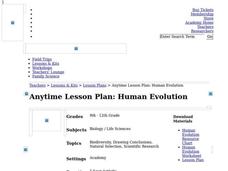Curated OER
Quiz on Insect Anatomy
In this insect anatomy quiz worksheet, students complete an on-line quiz, clicking on question and answer cards to complete and scoring 1 point per correct answer.
Howard Hughes Medical Institute
Comparative Anatomy of the Domestic Chicken
Are chickens and crocodiles really related? Young scientists compare the bone structure of current domestic chickens to other animals throughout evolution. This helps them understand the branches that separate crocodiles and birds as...
Curated OER
Coral Polyp Party
Students complete a project where they label the parts of a coral polyp and discuss the differences between plants and animals. Students use marshmallows, sprinkles, toothpicks, and more to label their coral polyp.
Curated OER
Invent an Insect
Explore biology by researching adaptation. First, learners research and define a list of insect vocabulary terms and discuss the benefits of each insect characteristic. They then utilize a worksheet to create their own insect and share...
Curated OER
Human Reproductive Processes Quiz
Quiz your learners on the reproductive process using this terminology assessment tool! Choose 1 of 2 options: have students play online, or make copies of the paper version. The advantage to playing the online matching game is its...
California Academy of Science
Fish Prints
What do a dead fish, conservation, and paint have in common? The answer is a great lesson about fish anatomy, fun print making techniques, and unsustainable fishing practices. The class will start by making fish prints with a...
Scholastic
Study Jams! Flowers
RJ hangs out in Zoe's garden as she explains pollination, flower anatomy, and fertilization. This cartoon-styled feature is sure to stay in your botanists' minds! Follow it with the dissection of large flowers, such as the lily.
Scholastic
Study Jams! Roots and Stems
Six slides come with information about roots and stems. In addition to the slide show, find a seven-question, multiple choice quiz and vocabulary guide. As a homework assignment, get your class to view the slides, take the quiz, print...
Scholastic
Study Jams! The Human Body
A brief set of anatomy slides introduces viewers to the five levels of organization (cells, tissues, organs, organ systems, and organisms). The slides focus on the muscular, circulatory, respiratory, and digestive systems.
Whitman College
Virtual Fetal Pig Dissection
Pigs and humans have the same metabolism level and similar organs and systems, which is why they are often used in scientific laboratories. This worthy virtual dissection of a fetal pig divides into eight chapters: anatomical references,...
California Academy of Science
Human Evolution
As the great and hilarious Tim Minchin once said, "Science is simply the word we use to describe a method of organizing our curiosity." Science is more than just a guess; it is based on questions, observations, and evidence. High...
Curated OER
Build a Coral Polyp
Students build a coral polyp out of a banana, straw, oyster crackers, sprinkles, and more. In this coral polyp lesson plan, students also list the differences between plants and animals.
California Academy of Science
Fish Forms
I've said it before, and I'll say it again, you can add art to any lesson! While little learners are discovering why fish have specific body parts such as, scales, fins, and gills, they start making three-dimensional fish forms. Children...
Howard Hughes Medical Institute
Winogradsky Columns: Microbial Ecology in the Classroom
Winogradsky columns are ideal for observing the role of bacteria and other microorganisms in an ecosystem. This student activity guide is complete with data tables for observations and analysis questions for processing what was observed....
Other popular searches
- Human Body Anatomy
- Animal Anatomy
- Brain Anatomy
- Animal Body Parts
- Anatomy and Physiology
- Flower Anatomy
- Human Body Anatomy Sketching
- Insect Body Parts
- Frog Anatomy
- Fish Characteristics
- Sexual Anatomy
- Anatomy Crossword













